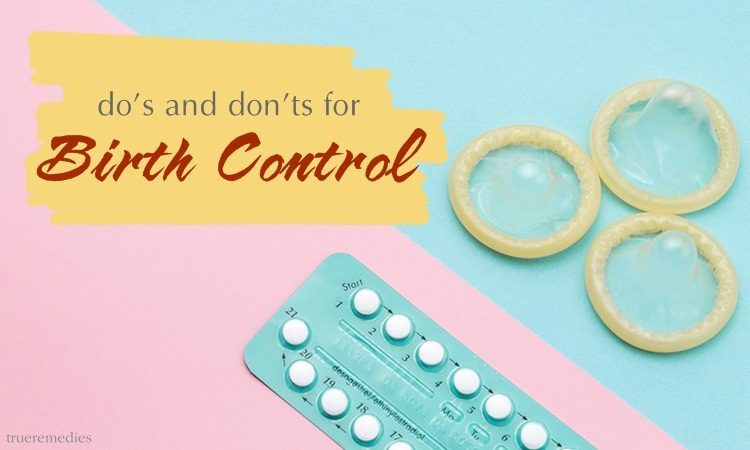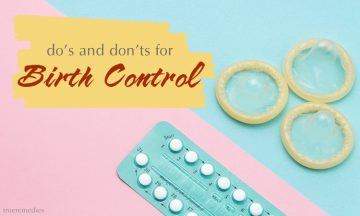Table Of Contents
With a large number of people in the world today, we focus more and more birth control (also known as contraception and fertility control). In addition, it is important for husband and wife or couples to have babies when they are ready to become parents, have good health and ability to nourish babies. In our article today on TrueRemedies, we will show you 6 do’s and don’ts for birth control.
6 Do’s And Don’ts For Birth Control You Should Follow
I. What To Do?
1. Condom
Why?
This is the most popular way for birth control because it is cheap and easy to use. Moreover, you can find a condom in any supermarket or drugstore. Condom helps prevent pregnancy by keeping sperm from getting into a woman’s body[1]. If you use condoms correctly when you have sex, they may reduce 98% of pregnancy with male condoms and 95% with female condom[2] [3]. Furthermore, condom also protects you from certain sexually transmitted infections (STIs) such as gonorrhea, chlamydia, HIV, and syphilis.
How to use?
- The penis must be fully erect
- Open the condom package carefully
- Unroll the condom by about 1/2 inch
- Place the condom on your penis. Remember to pinch the tip of the condom to remove air and leave space for semen
- Roll the condom down the penis
- After ejaculating (cum), hold tight the rim of the condom and remove the penis out of the partner’s body before your penis goes soft
- Throw the condom away in the garbage and do not throw it down the toilet because it can clog pipes
Note
- Check the expiration date first
- Never reuse a condom
- Do not use male and female condoms together
- Choose a condom with a famous brand such as Durex because fake condoms may not only give you babies but also cause some certain sexually transmitted infections(STIs)
2. Birth Control Pills
Why?
TrueRemedies Partner Solutions

Need a Help from the Leading Expert Online, Available 24/7?
They’re all here and ready to answer your questions online or by phone. Keep asking questions until you get the answer you need.
Taking birth control pills (also known as an oral contraceptive) correctly may reduce the risk of pregnancy by keeping the ovaries from releasing eggs[4]. If you take pills perfectly, the pill is about 99% effective. However, most people cannot take it correctly, so the effectiveness reduces to 91%[5] which means 9 out of 100 women may have pregnancy even if they use birth control pills. Moreover, birth control pills may help you relieve some health problems such as acne, bone thinning, serious infections in your ovaries, fallopian tubes, and uterus, iron deficiency (anemia), PMS (premenstrual syndrome), etc. [6]. Additionally, many women decide to use birth control pills to regulate menstrual period and reduce menstrual disorders[7]. However, using this pill does not prevent sexually transmitted infections (STIs). Therefore, even pills help prevent pregnancy, you still should use a condom while having sex.
How to use?
There are many types of birth control pills which you can easily find in the pharmacies. You should not use pills without asking a doctor’s advice. Remember to consult the doctor about the type and dosage of pills you can take. You also should tell the doctor about your health condition because some medications may reduce the effectiveness of birth control pills. Furthermore, pills may cause some side effects such as nausea, headache, etc., so let the doctor know immediately if you have adverse effects when using birth control pills[4].
3. Vaginal Ring
Why?
Women use this method will have a small, flexible, plastic ring which is inserted in the vagina. The vaginal ring is one effective way to prevent pregnancy by keeping the ovaries from releasing eggs[8]. Like most birth control pills, this ring contains the same hormones (progestin and estrogen), so it also helps you reduce the symptoms of some diseases such as acne. Having vaginal ring reduces the risk of getting pregnancy to 91%. However, it may not prevent sexually transmitted infections (STIs).
How to use?
- Squeeze the ring between your thumb and index finger and gently push it into your vagina
- If this is the first time you have used the ring, you should use other methods of birth control in addition to the ring for the first seven days after you insert the vaginal ring
- You can leave the ring for three weeks, and remove the ring for one week to have period. Start using a new ring after that
- Although the vaginal ring is easy to use, you should ask the doctor first. Moreover, do not forget to tell the doctor about your health condition because some medications may reduce the effectiveness of vaginal ring. In addition, if you see any side effects of this ring on your health, ask the doctor immediately.
4. Birth Control Patch
Why?
Many people choose to use a birth control patch (also called contraceptive patch) due to its convenience. The birth control patch is a thin, beige plastic square about two inches across that delivers hormones which will be absorbed through the skin. You do not need to use the birth control methods that interrupt sex such as a condom or remember to take pills everyday. Birth control patch is 91% effective in preventing pregnancy by stopping sperm from meeting an egg[9]. Moreover, the birth control patch may help treat some diseases such as acne[10]. However, it may not prevent sexually transmitted infections (STIs)
How to use?
- Apply the patch on the skin (except for your breast) each week for three weeks. Remember to take off and throw away the old patch. Be sure that you put a new patch on the same day each week
- Your skin must be clean and dry. Do not forget to check the patch regularly to make sure that it stays on the skin
- After three weeks, you have a week off to have periods
- Do not forget to consult a doctor before using the birth control patch because some people are taking other medicines which may result in the decline of birth control patch’s effectiveness. In addition, if you see any side effects of this ring on your health, ask the doctor immediately.
5. Birth Control Shot
Why?
Birth control shot is also a popular method to prevent pregnancy with 94% effective[11]. Women are injected progestin, one of the hormones found in birth control pills which keeps the ovaries from releasing eggs. Like birth control patch, you do not need to use the birth control methods that interrupt sex such as a condom or remember to take pills everyday when using birth control shot. However, it may not prevent sexually transmitted infections (STIs).
How to use?
- You need a doctor or a healthcare provider to help you
- Each shot lasts for about 12 weeks (about three months). Remember to get shot again on time
- Tell the doctor about your health condition and any side effects while using birth control shot
6. IUD
Why?
Unlike vaginal ring, an IUD is placed by a healthcare provider. The women will have a small T-shaped device placed in the uterus. Among the birth control methods, IUD is the most effective one because of 100 women who use an IUD each year, one or less may become pregnant. Moreover, it may works from 3 to 10 years depending on the type[12]. If women want to get pregnant, they may take this device out at any time and become pregnant immediately. Unfortunately, although it has many benefits in birth control, it may not prevent sexually transmitted infections (STIs).
How to use?
- You need a doctor or a healthcare provider to help you place the device
- You have to see the doctor regularly to check the placement
- Tell the doctor about your health condition and any side effects while using this method
II. What Not To Do?
It is necessary to not follow the natural methods for birth control because there is no evidence to prove that these methods are effective in avoiding pregnancy.
III. Common Mistakes
1. Using Both Male Condom And Female Condom Will Be More Effective?
No. Condom is effective when being used correctly. If you use male and female condoms at the same time may cause them to stick together, then break[13].
2. Birth Control Methods Protect Me Completely From Pregnancy?
No. Even if you use birth control methods correctly, you can still become pregnant. Birth control methods are not 100% effective. They just help you reduce the risk of getting pregnant.
All content provided is for informational & educational purposes. We recommend you consult a healthcare professional to determine which suggestion is suitable for you. We hope that this article gives you interesting and helpful information. If you have any questions or comments about the do’s and don’ts for birth control, please leave them in the comment box below. In short, please visit the New And Fact page to read more about the habits which are good or bad for your health.
Read more: 25 Natural Home Remedies For Morning Sickness Symptom Relief. This article was medically reviewed/fact checked by Janine Kelbach, BSN, RNC-OB.









